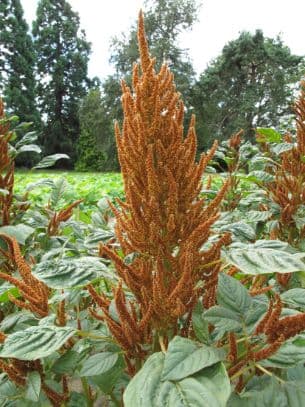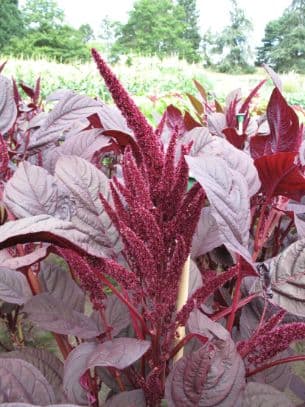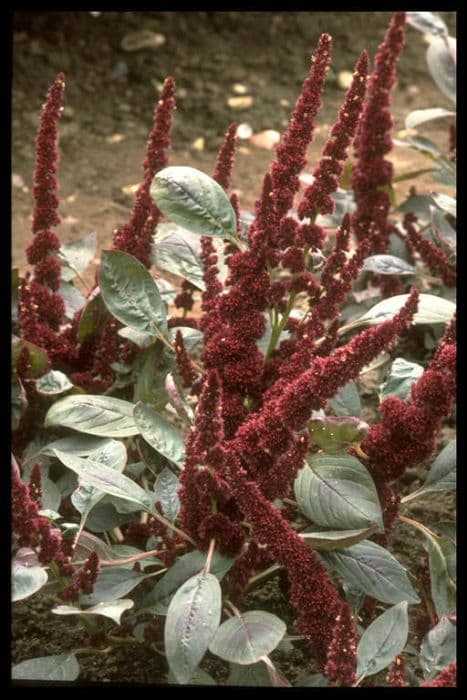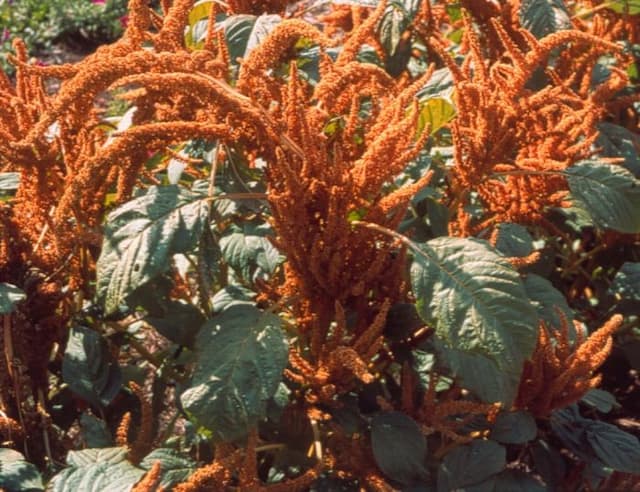Love-lies-bleeding Amaranthus cruentus 'Oeschberg'

ABOUT
Amaranthus cruentus 'Oeschberg', commonly known as amaranth 'Oeschberg', features striking foliage and dramatic flower spikes that make it stand out in any garden setting. The plant has deep purplish-red leaves that are oval to lance-shaped, often with a shiny, almost metallic sheen. These vibrant leaves provide a sharp contrast to the greenery around them and create a backdrop for the plant's signature feature: its flower spikes. The flowers of the 'Oeschberg' variety are produced in dense, erect clusters that tower above the foliage. These plumes are a rich, deep red to burgundy hue and add a vertical element to the plant's structure. The texture of the flower spikes is somewhat feathery, with numerous small flowers that give them a soft, yet robust appearance. Overall, the amaranth 'Oeschberg' is a plant that offers both rich color and interesting form. Its leaves and flowers combine to create a bold statement that can serve as an eye-catching focal point or as part of a mixed border that seeks to introduce striking colors and textures. The visual impact of amaranth 'Oeschberg' is one of drama and intensity, making it a popular choice for gardeners looking to add a bit of exotic flair to their plantings.
About this plant
 Names
NamesFamily
Amaranthaceae
Synonyms
Purple Amaranth, Love-Lies-Bleeding, Velvet Flower, Tassel Flower, Foxtail Amaranth, Prince's Feather
Common names
Amaranthus hybridus var. cruentus, Amaranthus paniculatus, Amaranthus cruentus.
 Toxicity
ToxicityTo humans
The plant known as Blood Amaranth generally is not considered poisonous to humans. However, amaranth leaves contain oxalic acid, which can be a concern for individuals with kidney problems or susceptible to oxalate-containing kidney stones. In large amounts, oxalic acid can combine with calcium to form calcium oxalate, which might precipitate as kidney stones. It's also worth noting that the raw leaves may have a higher concentration of oxalic acid, which can be reduced by cooking. There aren't typically severe symptoms associated with the consumption of Blood Amaranth in ordinary dietary amounts. Ingesting very large quantities might lead to gastrointestinal distress or exacerbate conditions related to kidney health, but this would be unusual.
To pets
Blood Amaranth is not commonly listed as a toxic plant to pets such as dogs and cats. Similar to humans, the concern with pets would mainly revolve around the oxalic acid content, which in high amounts can contribute to the formation of kidney stones and could potentially cause metabolic issues if consumed in large quantities. Common symptoms of oxalate poisoning in pets could include drooling, vomiting, diarrhea, lethargy, abdominal pain, or tremors. However, pets typically would have to consume a very large amount of amaranth to experience such symptoms. For most pets, incidental consumption of Blood Amaranth isn't likely to be harmful.
 Characteristics
CharacteristicsLife cycle
Annuals
Foliage type
Deciduous
Color of leaves
Green
Flower color
Red
Height
3 feet (0.91 meters)
Spread
2 feet (0.61 meters)
Plant type
Herb
Hardiness zones
2
Native area
Central America
Benefits
 General Benefits
General Benefits- Ornamental Value: The Amaranthus cruentus 'Oeschberg', commonly known as 'Oeschberg' Amaranth, features striking dark foliage and tassel-like flowers that add dramatic color and height to garden landscapes.
- Edible Parts: Both the leaves and the seeds of 'Oeschberg' Amaranth are edible, providing a nutritious addition to meals. The leaves can be eaten as a leafy vegetable, and the seeds can be used as a grain.
- Drought Tolerance: This plant is known for its ability to withstand dry conditions, making it suitable for xeriscaping or gardens in arid climates.
- Soil Enrichment: Amaranthus species are known to help in improving soil quality by adding organic matter, especially when used as green manure.
- Easy to Grow: 'Oeschberg' Amaranth is known for its ease of cultivation, requiring minimal care once established and adapting to a wide range of soil types.
- Attracts Wildlife: The flowers of 'Oeschberg' Amaranth can attract pollinators such as bees and butterflies, promoting biodiversity in the garden.
- Fast Growth: 'Oeschberg' Amaranth tends to grow quickly, providing swift coverage or biomass, which can be beneficial for creating garden features or for agricultural purposes.
- Gluten-Free Grain: The seeds of 'Oeschberg' Amaranth are gluten-free, making it a useful crop for those with gluten sensitivities or for adding diversity to a gluten-free diet.
 Medical Properties
Medical Properties- High nutritional content: Amaranth, including Amaranthus cruentus 'Oeschberg', is known for its high protein content and essential amino acids, beneficial for general nutrition.
- Antioxidant properties: The seeds and leaves of amaranth contain antioxidants like flavonoids and phenolic acids, which may help in reducing oxidative stress.
- Anti-inflammatory effects: Components in amaranth can have anti-inflammatory properties that might contribute to reducing inflammation in the body.
- Fiber content: Amaranth is rich in fiber which can aid in digestive health and help prevent constipation.
- Gluten-free: Amaranth is naturally gluten-free, making it a suitable grain alternative for those with celiac disease or gluten sensitivity.
 Air-purifying Qualities
Air-purifying QualitiesThis plant is not specifically known for air purifying qualities.
 Other Uses
Other Uses- Amaranth flowers can be used as a natural dye, providing a range of colors from pink to red, which can be used in textile and craft projects.
- The plant's dense foliage and growth habit make it an excellent choice for creating temporary green screens or privacy hedges in the garden.
- Dried Amaranth stalks can be used in floral arrangements, adding height and an interesting texture to bouquets or indoor displays.
- Due to its vibrant color and striking presence, Amaranthus 'Oeschberg' is popular as a decorative element in festivals and celebrations, particularly within cultural ceremonies that appreciate its symbolism.
- The seeds of Amaranth can be popped like popcorn which makes for a nutritious and crunchy snack.
- Its long lasting blooms and rich hues make Amaranthus 'Oeschberg' a popular choice for adding vibrant color to outdoor planters and containers.
- With its dense clumps, it can be planted to help prevent soil erosion on slopes and banks, thanks to its extensive root system.
- Amaranth leaves are edible and can be used as a salad ingredient, offering a colorful accent to various dishes.
- Parts of the plant can be used as feed for some livestock animals, providing a nutritious supplement to their diet.
- Used in art installations, Amaranthus 'Oeschberg' can create dramatic and organic shapes due to its upright growth and tassel-like flowering branches.
Interesting Facts
 Feng Shui
Feng ShuiThe Love-lies-bleeding is not used in Feng Shui practice.
 Zodiac Sign Compitability
Zodiac Sign CompitabilityThe Love-lies-bleeding is not used in astrology practice.
 Plant Symbolism
Plant Symbolism- Immortality: The name Amaranthus comes from the Greek word 'amarantos' which means 'unfading' and is symbolic of an everlasting, immortal nature.
- Unyielding: The hardiness and robustness of the plant signify determination and an unyielding spirit to survive despite challenges.
- Love Lies Bleeding: Commonly called 'Love Lies Bleeding,' it can symbolize hopelessness or unrequited love because of its drooping flower strands that resemble a bleeding heart.
- Captured Heart: In Victorian floriography, giving this plant could be a way to convey 'you have captured my heart' symbolizing deep affection.
- Infatuation: Giving these flowers could also mean that the giver is infatuated with the receiver, indicated by the intense color and dramatic appearance of the flowers.
 Water
WaterLove-lies-bleeding should be watered deeply once a week, providing about 1-1.5 inches of water each time, ensuring the soil is moist but not waterlogged. In particularly hot or dry conditions, it may require more frequent watering to maintain consistent soil moisture. Establish a regular watering schedule and adjust based on rainfall, temperature, and soil conditions; however, take care not to overwater, as this can lead to root rot. During winter or in cooler climates, the plant may require less water, so always check the soil before watering.
 Light
LightLove-lies-bleeding prefers full sun conditions and will thrive in a location that receives at least 6 to 8 hours of direct sunlight daily. The plant can tolerate partial shade, but its growth might be less vigorous, and it may produce fewer flowers. Ideal positioning would be in an unobstructed south or west-facing spot where it gets ample sunlight throughout the day.
 Temperature
TemperatureLove-lies-bleeding grows best in temperatures between 65°F and 80°F, thriving in warm conditions. It can withstand a minimum temperature of 50°F but may not survive if the temperature falls below freezing. During the growing season, keep it in a place that's consistently warm and avoid exposure to cold drafts or sudden temperature fluctuations.
 Pruning
PruningPruning love-lies-bleeding is mainly done to remove spent flower heads and encourage new growth. Deadheading, or removing faded flowers, can be done throughout the growing season as needed. Cut back the plant to the ground in late fall or early winter after the first frost. Pruning is also an opportunity to shape the plant for aesthetic purposes or to maintain size.
 Cleaning
CleaningAs needed
 Soil
SoilLove-Lies-Bleeding thrives in well-draining soil with a blend of garden soil, compost, and perlite or sand, pH 6.0-7.5.
 Repotting
RepottingLove-Lies-Bleeding doesn't require frequent repotting; do it only when it's root-bound, usually every 2-3 years.
 Humidity & Misting
Humidity & MistingLove-Lies-Bleeding prefers moderate humidity but is adaptable to normal room humidity levels.
 Suitable locations
Suitable locationsIndoor
Place Love-Lies-Bleeding in bright light and turn for even growth.
Outdoor
Plant Love-Lies-Bleeding in full sun with good soil drainage.
Hardiness zone
2-11 USDA.
 Life cycle
Life cycleAmaranthus cruentus 'Oeschberg', commonly known as 'Oeschberg' amaranth, begins its life cycle when its small black seeds germinate, usually in late spring when the soil temperature reaches an ideal range of 68-75°F (20-24°C). The seedlings emerge, and in this vegetative stage, the plants develop their distinctive dark red foliage and branched structure over the course of several weeks. As the plants mature, they enter the flowering stage, producing dense, feathery flower spikes that can vary in color but often maintain a rich, reddish hue. Following pollination, which can be facilitated by wind or insects, the plant proceeds to the fruiting stage, where it forms small, dry fruits known as utricles that encase the seeds. Once mature, the seeds can be released to the soil for natural reseeding or collected for cultivation. After seed dispersal, the amaranth plant begins to senesce and eventually dies, completing its annual life cycle.
 Propogation
PropogationPropogation time
Spring-summer
Propogation: The Love-Lies-Bleeding, known scientifically as Amaranthus cruentus 'Oeschberg', is most commonly propagated through seeds. The optimal time for sowing Love-Lies-Bleeding seeds is in the spring, after the last frost when the soil has warmed up to at least 60 degrees Fahrenheit (about 16 degrees Celsius). To propagate, seeds should be sown directly into well-drained soil at a shallow depth of about 1/4 inch (around 6 millimeters). It is important to keep the soil consistently moist until germination, which typically occurs within 7 to 14 days. Once seedlings have emerged and grown strong enough, thin them to stand about 18 inches (approximately 46 centimeters) apart to allow for proper air circulation and growth.









